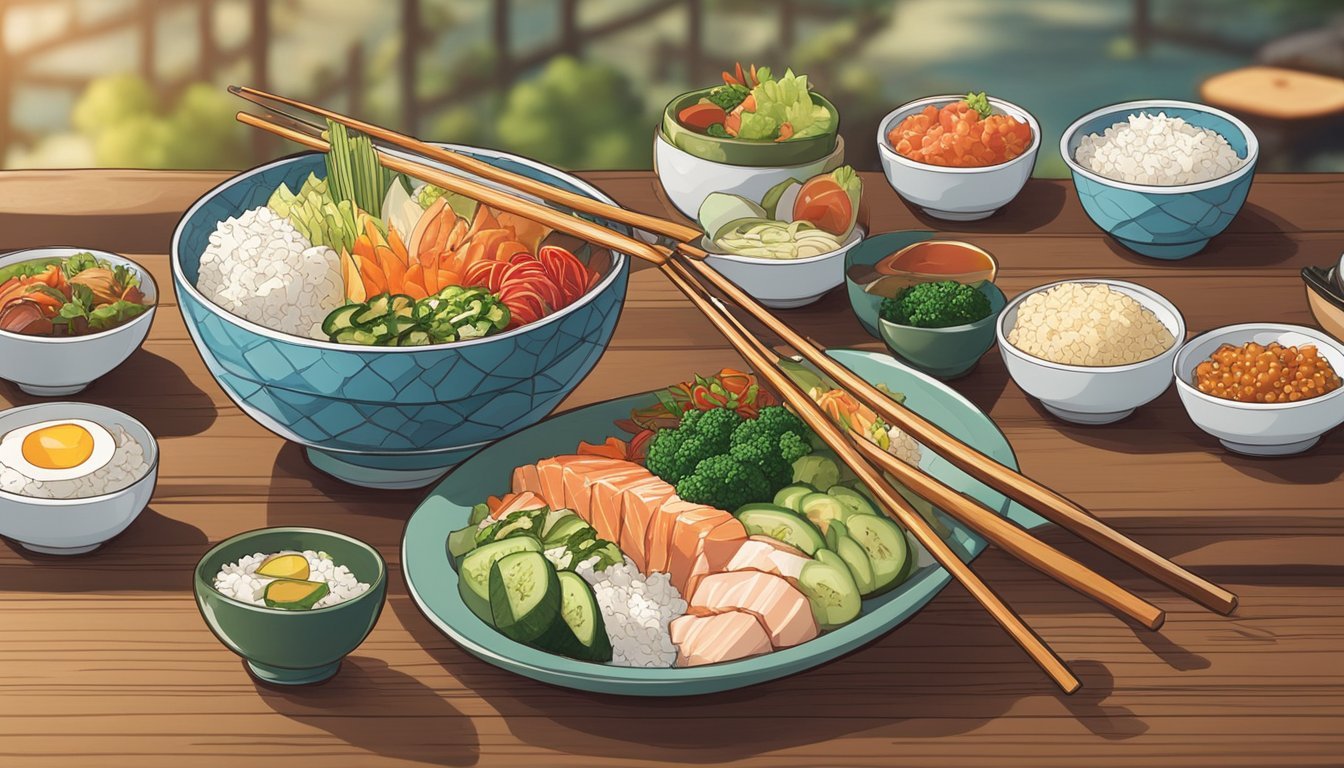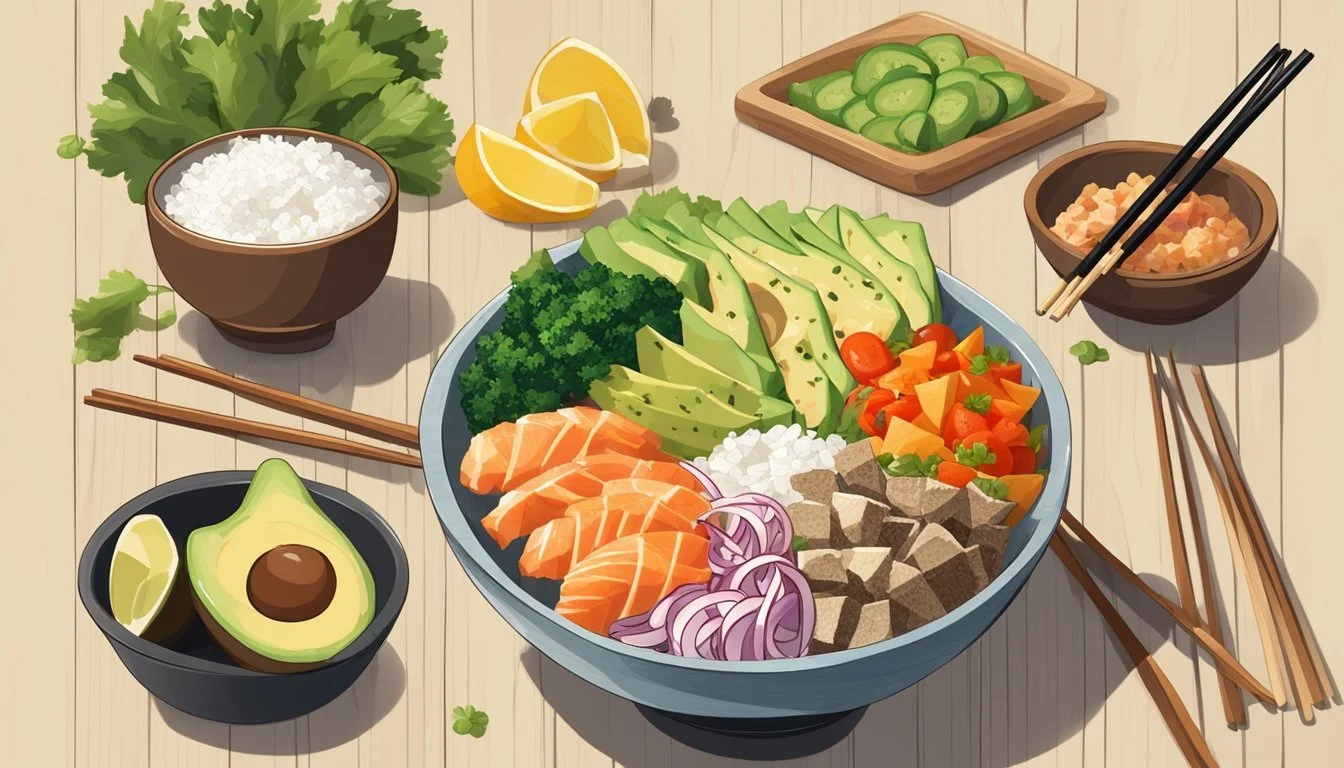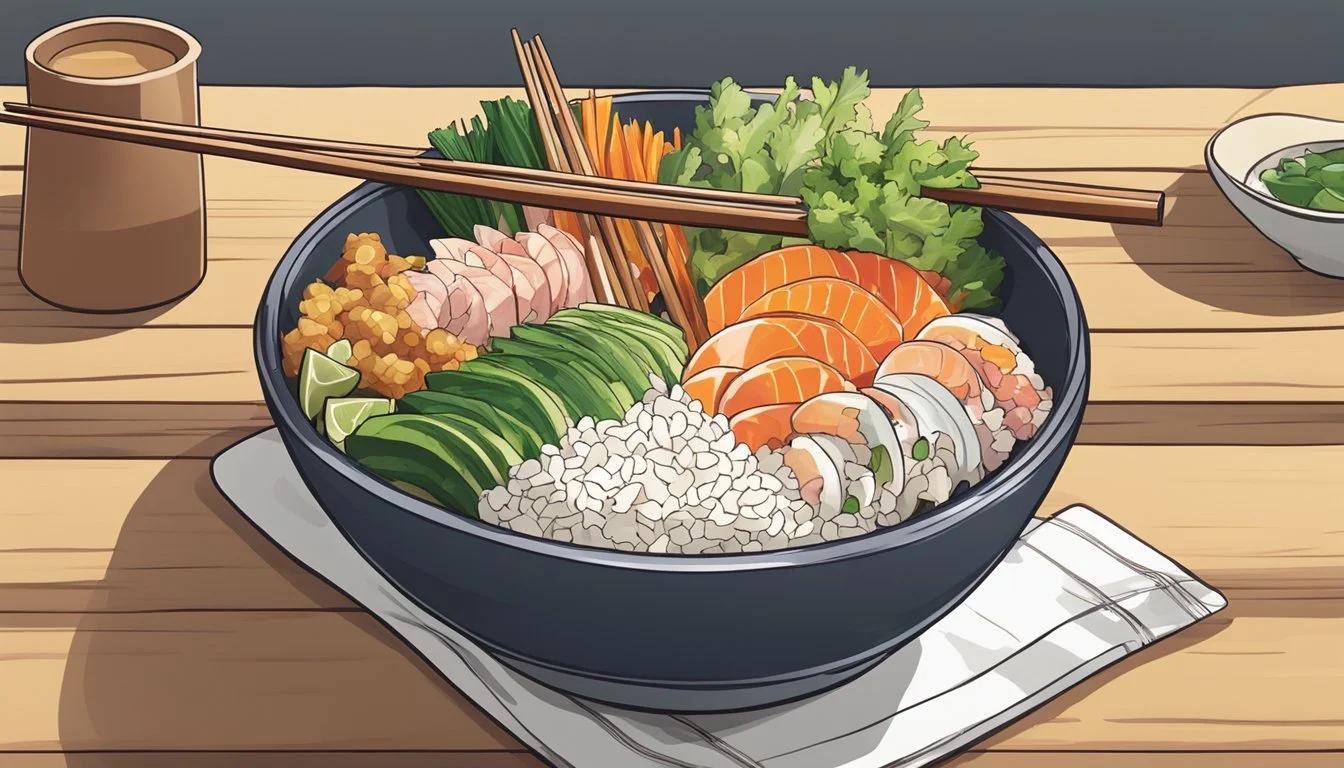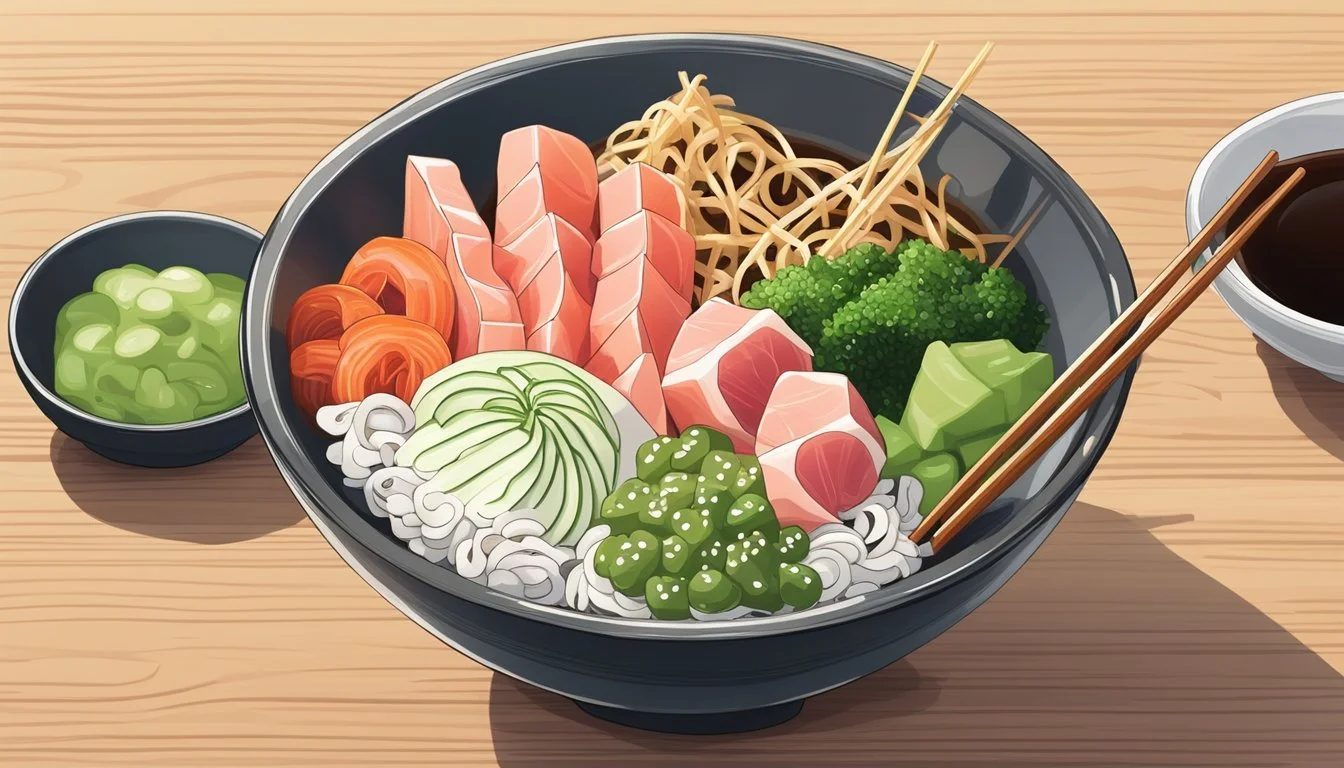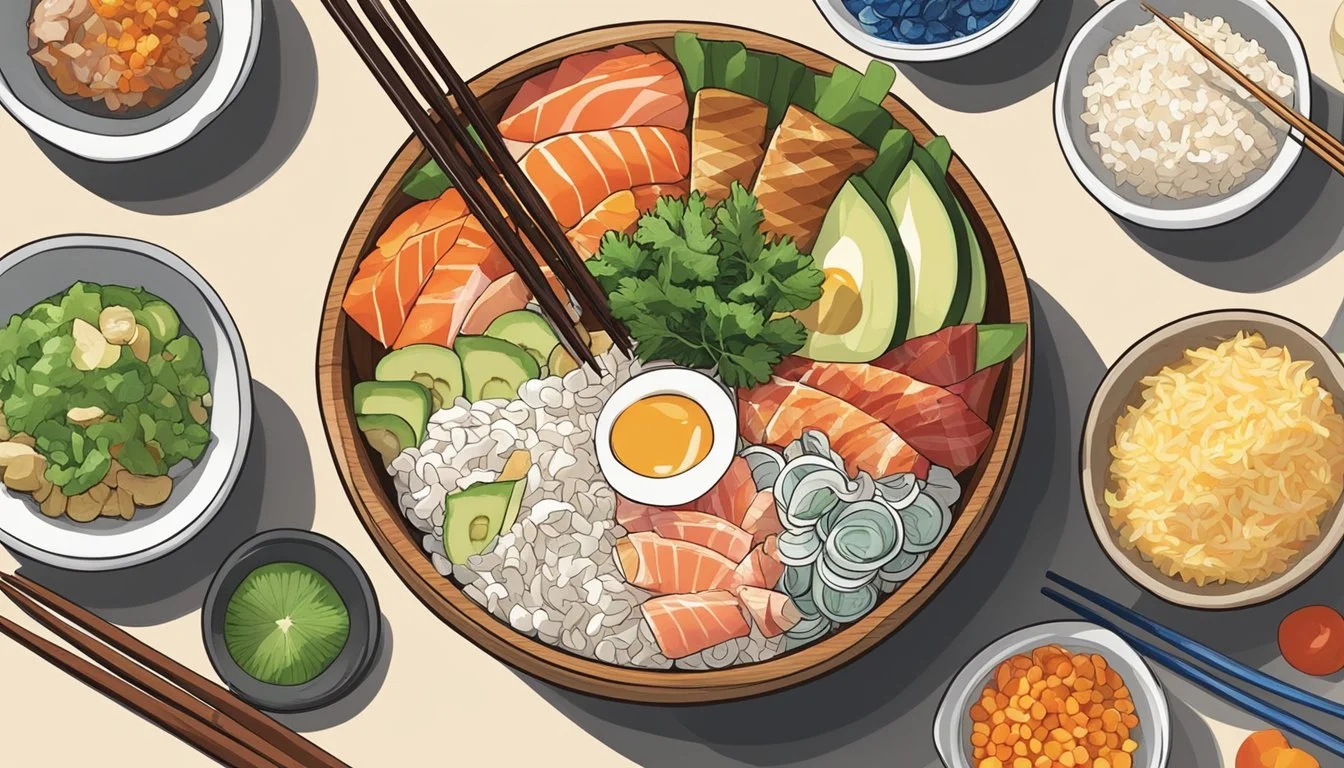How Do You Eat a Poke Bowl?
Essential Tips for Enjoying This Hawaiian Dish
A poke bowl is a traditional Hawaiian dish with roots in Japanese cuisine that has gained worldwide popularity. It typically consists of diced raw fish, usually ahi tuna or salmon, (What wine goes well with salmon?) served over a bed of rice or leafy greens. The dish is known for its vibrant presentation as well as its mix of textures and flavors. Seasonings such as soy sauce, sesame oil, and green onions often accompany the fish, with additional toppings like avocado, cucumber, seaweed salad, and pickled vegetables (What wine goes well with pickled vegetables?) contributing to the unique taste and nutritional profile of each bowl.
The versatility of the poke bowl is part of its appeal. Diners can customize their bowl to suit their taste preferences and dietary needs, perhaps opting for a base of cauliflower (how long does cauliflower last?) rice or quinoa rather than the traditional sticky rice. Accompaniments may include a variety of vegetables, nuts, seeds, and dressings, providing a balance of proteins, fats, and carbohydrates.
Eating a poke bowl is straightforward. It can be mixed together before eating to combine all the flavors, or ingredients can be savored individually to appreciate their distinct tastes. Whether looking for a quick lunch or a nutritious dinner, the poke bowl offers a satisfying meal that's as pleasing to the eye as it is to the palate.
Understanding Poke Bowls
Poke bowls are a traditional Hawaiian dish that present a delicious blend of flavors and textures centered around marinated raw fish. These bowls have evolved to include a variety of ingredients, offering a customizable eating experience.
Origins and History
The poke bowl has its roots in Hawaii, where it began as a simple dish made by fishermen who would season the cut-offs from their catch, typically ahi tuna (What wine goes well with tuna?), with salt, seaweed, and kukui nuts. This humble mix, known simply as poke, has been a staple of the Hawaiian diet for centuries. The name 'poke' itself means "to slice" or "to cut crosswise into pieces" in Hawaiian.
Basic Components
The basic components of a poke bowl include:
Base: Usually sushi-grade rice, though alternatives like brown rice, quinoa, or greens are common.
Protein: Traditionally raw fish such as ahi tuna or salmon. Variations include cooked proteins like chicken or plant-based options like tofu for a vegan alternative.
Mix-ins: A selection of vegetables and other toppings to add texture and flavor.
Sauce: Used to marinate the protein and dress the bowl, often a soy sauce or sesame oil-based dressing.
Poke Bowl Varieties
Poke bowls have seen a multitude of variations, with each ingredient customizable according to personal preference. Some popular types include:
Traditional Hawaiian Poke: Features raw fish with minimal toppings, focusing on the freshness of the fish.
Modern Poke: Circles the globe in influences, adding avocados, mangoes, edamame, seaweed salad, and a plethora of sauces like spicy mayo and ponzu.
By staying true to its origins while embracing a modern twist, the poke bowl offers a unique dining experience that continues to delight palates worldwide.
Selecting Ingredients
Crafting the perfect poke bowl hinges on the careful selection of high-quality ingredients that come together to create a harmonious blend of flavors and textures.
Choosing the Right Fish
When selecting fish for a poke bowl, one should prioritize sushi-grade or sashimi-grade seafood to ensure both safety and taste. Ahi tuna, including yellowfin, and salmon are popular choices, renowned for their rich flavor and tender texture. One should look for freshness, a firm feel, and a bright, uniform color.
Rice Types and Alternatives
The traditional base for a poke bowl is sushi rice, appreciated for its sticky texture and slightly sweet flavor. However, options like brown rice offer a nuttier profile and enhance the bowl's nutrition. For a low-carb alternative, cauliflower rice or quinoa can be substituted, adjusting the bowl's texture and nutrient composition accordingly.
Vegetables and Toppings
A variety of veggies can be integrated for crunch and nutrition, including:
Cucumbers: for a fresh, crisp element
Edamame: adding a protein boost
Carrots: for sweetness and crunch
Seaweed: providing a unique ocean flavor Toppings such as tender avocado slices, green onions, and sweet diced mango contribute to the complexity of the bowl's profile. One can also toss in edamame for extra protein or garnish with sesame seeds to enhance textures and flavors.
Preparation Techniques
The proper preparation of a poke bowl centers on three critical aspects: selecting a suitable base, cutting and handling sushi-grade fish with care, and marinating the chunks for a harmonious balance of flavors.
Preparing the Base
A poke bowl's foundation is typically a bowl of rice, but alternatives like brown rice or cauliflower rice offer a nutritional variety. One begins by cooking the rice and letting it cool slightly to reach a suitable temperature that won't cook the raw fish when combined. The ideal quantity is about 1 to 1½ cups of rice per serving.
White Rice: Steam until fluffy and cool to just below room temperature.
Brown Rice: Offers a nuttier taste and chewier texture, prepare similarly to white rice.
Cauliflower Rice: For a low-carb option, it can be lightly steamed and cooled.
Cutting and Handling Fish
Selecting sushi-grade fish is paramount to ensure safety and quality. The fish should be kept refrigerated until it's cut into bite-sized cubes, about 1 inch each. It's critical to use a sharp knife and cut the fish cleanly to preserve texture and ensure even marinating.
Sushi-Grade Fish: Always use the freshest fish available, specifically labeled for raw consumption.
Cut: Use a sharp knife to create uniform cubes for consistent marinating and flavor.
Marinating the Poke
Once the fish is cut, one must gently toss it in a marinade—a critical step that imparts flavor and tenderizes the fish. A simple marinade might consist of soy sauce, sesame oil, and optional seasonings like scallions or sesame seeds. Fish should marinate for at least an hour but not longer than 24 hours to ensure it does not become overly salty or tough.
Soy Sauce and Sesame Oil: Essential components of the marinade for traditional flavor.
Marinate Time: At least 1 hour to allow flavors to infuse the fish without compromising texture.
Assembling the Poke Bowl
When assembling a poke bowl, balance, texture, and flavorful components are key to creating a satisfying dish. They start by selecting a base, typically rice—white, brown, or sushi rice are popular choices, given their ability to complement the main ingredients.
Next, he or she prepares the poke—fresh, sushi-grade fish cut into ¼ inch cubes. Common fish choices include ahi tuna or salmon. For added flavor, one can marinate the fish in a simple mixture of soy sauce and sesame oil, letting it absorb the flavors.
Then, they focus on the variety of textures and flavors by choosing a range of toppings. A combination of diced cucumber, edamame, pickled ginger, and thinly sliced radishes offers a mix of crunchy, pickled, and fresh elements. Sprinkle over some green onions, black sesame seeds, or furikake for added texture and a pop of color.
Finally, for the sauce, pour a drizzle over the poke bowl. Classic options include a light soy sauce dressing, spicy mayo, or a sweet teriyaki sauce. Adjust the amount depending on personal preference for a more or less saucy poke bowl.
Below is a suggested order to assemble a poke bowl for optimal taste and presentation:
Base: A scoop of rice
Protein: Marinated fish, evenly distributed
Toppings: Variety of vegetables and seasonings
Sauce: Final drizzle, glazing the contents
They can make their own poke bowl recipe at home, following these steps for an ideal combination of flavors and textures. The process is straightforward, allowing anyone to create a personalized bowl tailored to their tastes.
Seasonings and Sauces
The right combination of seasonings and sauces can transform any poke bowl from good to exceptional. They are not just garnishes but integral components that bring balance, depth, and personalization to the dish.
Classic and Modern Dressings
Classic: The foundation of any poke bowl sauce begins with soy sauce, often complemented by the nutty flavor of sesame oil. The inclusion of rice vinegar adds a subtle tanginess, while ingredients like wasabi and spicy mayo—comprising mainly of mayonnaise mixed with sriracha or a similar chili paste—contribute to the distinctively creamy and spicy notes. Ponzu sauce, a citrus-enhanced soy sauce, introduces a delicate blend of savory and tangy profiles.
Modern Twists: Contemporary dressings expand on the classics with creative flair. Teriyaki sauce brings sweetness and depth with its blend of soy sauce, sugars, and mirin, frequently garlic-ginger seasoned and thickened to coat the bowl's components satisfyingly. Some dressings might also introduce lemon juice for freshness or include global infusions such as Thai-inspired sweet chili sauce for a hint of sweetness alongside heat.
Herbs and Spices
Herbs: Fresh herbs like cilantro bring color and freshness to poke bowls, and are often chosen to complement the selected sauce. They provide a burst of herby taste that contrasts the rich, savory flavors commonly found in the sauce.
Spices: To finish, a proper seasoning blend can include kosher salt, sesame seeds, red pepper flakes, or dried seaweed. The latter is grounded into a fine powder for a salt alternative that imparts umami. Regular adjustments and moderate additions of garlic and ginger are recommended as they can overpower the dish if used excessively.
Health and Nutrition
When considering the health and nutrition of poke bowls, it's important to assess both the caloric content and nutrient profile, and understand how they fit into various dietary considerations.
Caloric and Nutrient Analysis
Poke bowls typically start with a base of rice or greens, followed by layers of raw fish such as tuna or salmon, and a variety of toppings including vegetables and sauces. A standard poke bowl with 4 ounces of fish is relatively low in calories while offering a robust amount of protein. For example:
Calories: A serving might contain just under 150 calories.
Protein: It might provide about 24 grams of protein.
Fat: Healthy fats, especially when avocado is included, are often present in moderate amounts—around 5 grams.
These bowls are not only nutritious but can also be tailored to accommodate a balanced diet. The inclusion of vegetables adds essential vitamins and minerals, while the choice of fish like tuna and salmon contributes omega-3 fatty acids, known for their beneficial heart health properties.
Diet Considerations
Poke bowls can be adjusted to meet a variety of dietary needs:
Gluten-Free: Selections like rice or vegetable bases make poke bowls easily gluten-free.
Vegan: Options exist for plant-based proteins, substituting fish for tofu or tempeh (What wine goes well with tempeh?).
Healthy Fats: Incorporating avocado offers a source of monounsaturated fats.
Balanced Diet: The combination of lean protein, healthy fats, and vegetables provides a foundation for a balanced diet.
By choosing whole grain or vegetable bases, and opting for low-mercury fish or plant-based proteins, consumers can increase the health benefits of poke bowls. Limiting added oils, sauces, and high-sodium condiments helps maintain the nutritional integrity of the meal.
Serving and Consumption
When one is ready to enjoy a poke bowl, it is important to consider the size of the portion and the manners in which it is consumed, both influenced by culture and tradition.
Ideal Servings
An ideal serving of a poke bowl typically consists of 1 lb. of freshly cut raw fish, which can be divided into 2-4 servings depending on the size of the bowl and the number of additional toppings. A typical base would be warm sushi rice, although salad greens can be an alternative for those seeking a lighter option. The fish is most often cubed for ease of eating and even distribution of flavor. Seasonings such as a simple soy sauce marinade are used to accentuate the taste of the fish.
Eating Etiquette
When consuming a poke bowl, the use of cutlery is determined by personal preference and tradition; however, chopsticks or a fork are the most commonly used tools. One should mix the ingredients together before eating to ensure each bite carries an even distribution of flavors from the seasonings and sauces. In Hawaii, where the poke bowl originated, eating it is an informal experience often enjoyed as both an appetizer or a main dish. It's encouraged to embrace the harmonious blend of flavors and textures, enjoying each ingredient without picking the bowl apart.
Recipes and Variations
The versatility of poke bowls allows for both traditional and innovative takes on this Hawaiian favorite. By maintaining a balance of taste and nutrition, one can either stick to the original recipes or opt for a unique twist that caters to various dietary preferences.
Classic Poke Bowl Recipe
Ingredients:
1 lb sushi-grade ahi tuna, diced
2 cups sushi rice, cooked
1/4 cup soy sauce
1 tablespoon sesame oil
1 teaspoon rice vinegar
1 tablespoon honey
1/2 teaspoon ginger, grated
Scallions, chopped (reserve some for garnish)
Sesame seeds
Instructions:
Marinate the tuna by combining soy sauce, sesame oil, rice vinegar, honey, and ginger in a bowl. Add the diced ahi tuna and gently toss to coat. Sprinkle with sesame seeds and chopped scallions. Cover and refrigerate for 15 minutes to an hour.
Assemble the bowl by placing a base of cooked sushi rice, then top with the marinated ahi. Garnish with additional sesame seeds and scallions.
Creative Twists on the Traditional
For those seeking an alternative to the classics, various poke bowl recipes cater to different diets, including vegan options.
Vegan Poke Bowl:
Substitute the ahi tuna with sautéed tofu or marinated chickpeas for a protein-packed vegan alternative.
Replace the sushi rice with cauliflower rice or mixed steamed greens for a lower-carb base.
Add a variety of diced veggies like cucumbers, carrots, and radishes for crunch and nutrition.
Make Your Own Unique Poke Bowl: One can create their own poke bowl by mixing and matching a range of ingredients. Balance is key; ensure a good mix of proteins, vegetables, and a flavorful dressing. Here's how to make your own:
Choose a Base: Sushi rice, brown rice, cauliflower rice, or salad greens.
Pick a Protein: Options include sushi-grade fish like ahi tuna or salmon, cooked shrimp, tofu, or tempeh.
Add the Vegetables: Avocado, cucumber, radish, edamame, and seaweed are popular choices.
Sauce It Up: Use soy sauce, tamari, sesame oil, or Sriracha aioli to add depth of flavor.
Garnish: Finish off with sesame seeds, scallions, pickled ginger, or crispy onions for texture.
By making thoughtful choices with each component, one can craft a poke bowl that is both satisfying and tailored to individual tastes.
Pairings and Accompaniments
When enjoying a poke bowl, one is treated to a colorful assembly that often includes marinated fish. To elevate the dining experience, certain side dishes can complement the main attraction. Seaweed salad, with its unique umami flavor and crisp texture, pairs wonderfully with the richness of the marinated fish. It provides a refreshing contrast that is both palate-cleansing and nutritionally beneficial.
Edamame, tender young soybeans still in their pods, make for an ideal accompaniment. Their subtle, earthy taste and high protein content add another layer of satisfaction to the meal, without overshadowing the main ingredients. For an added twist, they can be lightly seasoned with salt or tossed with garlic for extra flavor.
For those who appreciate the nuances of sushi-grade fish, sushi rice or even sashimi slices can be included on the side. Sushi rice, with its slight stickiness and vinegar tang, supports the smooth, delicate textures of the fish. Meanwhile, sashimi provides diners with an opportunity to taste the seafood in its most pristine form, enhancing the authentic flavors present in the poke bowl.
Lastly, ensure that the fish used in the poke bowl is sushi-grade for both safety and quality. This designation means it's suitable for raw consumption, ensuring peace of mind when indulging in these delectable pairings.
When selecting accompaniments, consider balance in both flavor and texture to perfect the poke bowl experience.
Food Safety Considerations
When enjoying poke bowls, it is imperative that consumers place a priority on food safety, especially because these dishes often contain raw ingredients such as fish which are susceptible to spoiling. Attention to the freshness of ingredients and how they are stored and handled is crucial to preventing foodborne illnesses.
Selecting Fresh Ingredients
Raw fish, the star of any poke bowl, should be specifically marked as sushi-grade to signify it has been handled with the strictest of standards ensuring safety for raw consumption. Freshness is paramount, so one should always:
Inspect the color and smell: Fresh fish should have a bright appearance and a clean ocean scent; any fishy or ammonia-like odors indicate it's past its prime.
Purchase from reputable sources: Vendors who specialize in sushi-grade fish are more likely to follow proper temperature control and handling procedures.
Proper Storage and Handling
Post-preparation storage and the handling of a poke bowl are critical to maintain safety:
Temperature Control: Raw fish should be kept at or below 4°C (39°F) to slow the growth of pathogens.
Marination: While marinating can provide some acidic barrier to bacteria on the fish, it should not be relied upon for making the fish safe.
Poke bowls are best enjoyed immediately after preparation, but if one must store them, the following guidelines should be adhered to:
Storage Timeframe Action Within 1 day Optimal period for consumption; store in the fridge 1-2 days Maximum window for leftovers; keep refrigerated and tightly covered
It's crucial to remember that when handling poke, one must always keep utensils and surfaces clean to prevent cross-contamination.
Cultural Significance and Trends
Poke bowls carry deep cultural roots in Hawaiian traditions and have seen a remarkable rise in popularity, leading to global adaptations and a wide array of preparation styles that cater to shifting tastes and seasonal ingredients.
Poke Bowls in Hawaiian Culture
In Hawaii, poke is much more than just a food trend; it's a longstanding culinary tradition. The classic Hawaiian poke bowl typically features cubed ahi tuna, often marinated to enhance its natural flavors. This dish signifies the unique, maritime-centric approach of Hawaiian cuisine, showcasing the freshness and quality of local seafood.
Global Popularity and Adaptations
The international rise of the poke bowl can be tracked back to its explosion in the US mainland during the 1970s and 1980s. Today, this Hawaiian dish has been enthusiastically adopted and adapted around the world, accommodating the international palate with variations that sometimes stray far from the original recipe. Cities from New York to Santa Monica have established eateries that serve customized poke bowls, demonstrating its versatility and global appeal.
New York: Wisefish Poké, Sweetfin Poké
Santa Monica: Sweetfin Poké
Trends in Poke Bowl Preparations
Modern poke bowl preparations often respect the core concept of the dish while introducing creative twists. Seasonal variations and fusion flavors reflect a movement towards both local uniqueness and international tastes. Ingredients like quinoa, kale, and fruit additions signal a trend in poke bowls evolving to meet the desires for health-conscious and on-trend eating options. Despite these many changes, the essence of the poke—freshness and quality—remains a constant priority.
Frequently Asked Questions
When it comes to poke bowls, enthusiasts and newcomers alike often have questions pertaining to their nutritional content, how to handle dietary restrictions, and tips for creating the perfect poke experience at home.
Nutritional Content Queries
Q: What are the nutritional benefits of a poke bowl?
A: Poke bowls often provide a good balance of proteins, especially from the fresh fish like ahi tuna, which is rich in Omega-3 fatty acids. One can calculate the caloric intake using nutritional calculators available at numerous Hawaiian food restaurants, allowing for a tailored poke bowl that fits specific dietary goals.
Q: Can a poke bowl be considered a low-calorie meal option?
A: Yes, by choosing the right ingredients such as lean proteins, avoiding high-calorie sauces, and opting for bases like salad or cauliflower rice instead of white sushi rice, a poke bowl can be a part of a low-calorie diet.
Allergy and Dietary Restriction Concerns
Q: How can I customize my poke bowl to fit my dietary restrictions?
Vegetarian/Vegan: Substitute fish for tofu or tempeh, ensuring all add-ons and sauces are plant-based.
Food Allergies: Avoid ingredients that may trigger allergies. Many restaurants provide allergen information for their dishes.
Best Practices for At-Home Preparation
Q: What are some tips for preparing a poke bowl at home?
A: Use fresh, sushi-grade fish to ensure both safety and quality. Simple techniques such as cutting the fish into uniform cubes and tossing with a mixture of soy sauce, sesame oil, and rice vinegar can enhance flavors. Ingredients should be mixed gently to maintain their integrity.
Q: Is long marination necessary for the fish?
A: No, a brief marination of 30 minutes to 2 hours is sufficient. This allows the fish to take on the flavors without becoming overly cured.
Summary and Final Thoughts
Eating a poke bowl is a culinary art that combines simplicity with a blend of flavors and textures. It provides a wholesome dining experience and an opportunity to enjoy a mix of fresh ingredients and bold seasonings in a single dish.
Ingredients Preparation Base (e.g., rice, salad) Place at the bottom of the bowl Raw fish (commonly tuna) Cube and marinate adequately Vegetables (e.g., edamame, avocado) Slice or dice for topping Seasonings (e.g., soy sauce, sesame oil) Drizzle to enhance flavors Toppings (e.g., seaweed, masago) Add for additional texture and taste
When assembling a poke bowl, one should start with a base—typically rice or greens—followed by adequately marinated fish, like tuna or salmon. Additional layers of flavor come from a variety of toppings and sauces.
A good poke bowl depends on fresh, high-quality ingredients. Each element must be prepared with care, ensuring that the fish is fresh and the vegetables are crisp.
When dining, it is essential to mix the elements before eating to ensure every bite contains an array of flavors. Whether for a quick lunch or a casual dinner, the poke bowl caters to a range of tastes, offering a nutritious and satisfying meal.
In conclusion, appreciating a poke bowl is as much about the preparation as it is about the eating. The diner's ability to customize their bowl makes it a versatile option for any mealtime.

